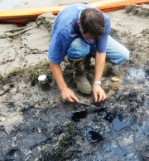Two professors will try to find ways to accelerate the chemical breakdown of hydrocarbons using naturally occurring marine organic matter.
The public is invited to various meetings in Texas, Colorado, Pennsylvania and New York during the month of July.
USDA-ARS study finds that filter socks lowered sediment concentration 49 percent in runoff from a tilled field.
Covering 10 percent of a watershed with impervious cover can cause as much as one-third of a decline in pollution-sensitive aquatic insects.
University of Arkansas research suggests hydrochlorofluorocarbons, which were meant to protect the ozone, may contribute to climate and acid rain problems.
Researchers note that Taiwan is heavily industrialized with many municipal incinerators that release PCDDs and PCDFs.

Between 35,000 and 60,000 barrels of oil per day may be leaking from the BP oil well in the Gulf of Mexico.
National Toxicology Program reviews Ramazzini Institute studies and suggests further pathology reviews are needed to resolve differences of opinion.
Data from the study will be fed into hydraulic models and ultimately will help authorities make informed decisions about water uses.

Low-cost canine method could replace DNA-based technique.

Researchers from several organizations tested visible near infrared light with diffuse reflectance spectroscopy to determine the presence and amount of oil in Louisiana soils.
Working for TVA, the lab is continuing its research to determine if selenium and other contaminants will have a long-term effect on fish populations.
Lead paint rule spurred RTI International to develop a method that uses a simple, portable turbidity meter that measures the amount of light blocked by suspended particles in solution.
Agency is in discussions with Makhteshim Agan of North America, the insecticide's manufacturer.

Deeper wells will be useful for safer drinking water, but not for irrigation water that relies on mechanized pumps that speed arsenic migration.

Scientists collected outflow samples periodically from 2004 to 2009 from three New York wastewater treatment plants, two of which receive more than 20 percent of their wastewater from pharmaceutical manufacturing facilities.
The method uses land cover data derived from NASA satellites to refine geospatial cropland carbon fluxes nationwide.

California Air Resources Board and the National Oceanic and Atmospheric Administration will be using airplanes, ships and researchers to find the nexus of air pollution and climate change.
The researchers observed a dose-response association between increasing urine BPA level and declining male sexual function of 427 factory workers in China.